View in other NatureServe Network Field Guides
NatureServe
Montana
Utah
Wyoming
Idaho
Wisconsin
British Columbia
South Carolina
Yukon
California
New York
Red Fox - Vulpes vulpes
Native Species
Global Rank:
G5
State Rank:
S5
(see State Rank Reason below)
Agency Status
USFWS:
USFS:
BLM:
External Links
State Rank Reason (see State Rank above)
Species is common and widespread, but slightly declining. It faces no threats.
General Description
Appearance of small dog. Long, bushy tail, pointed ears, slender muzzle, slanted eyes. White tip on the tail. Rufous coloration, various coat colorations or color phases. Total length: 39 to 43 inches. Weight: 10 to 15 pounds.
Diagnostic Characteristics
There is no white tip on the tail of the Coyote, Swift Fox, Marten or Fisher.
Species Range
Montana Range
Range Descriptions
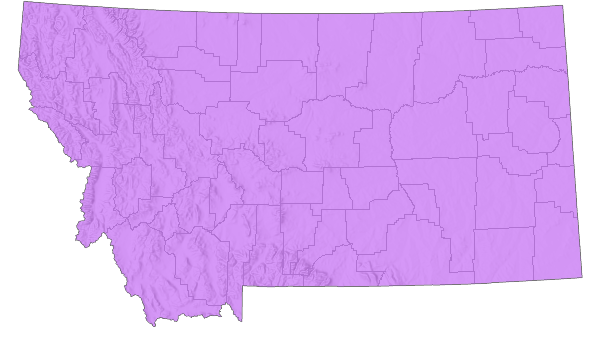
 Native
Native
Global Range

Estimated global breeding range area is: 68,683,696 km
2 (Approximately 1% in Montana)
See information about
 iNaturalist Geomodels
iNaturalist Geomodels
Observations in Montana Natural Heritage Program Database
Number of Observations: 1493
(Click on the following maps and charts to see full sized version)
Map Help and Descriptions
Relative Density
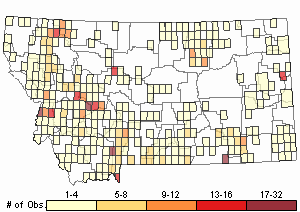
Recency
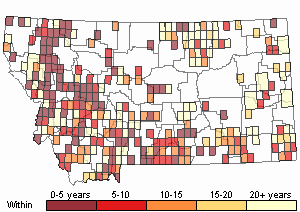
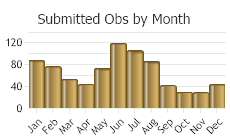
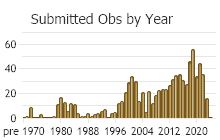
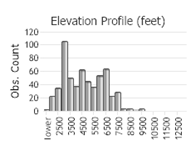 (Observations spanning multiple months or years are excluded from time charts)
(Observations spanning multiple months or years are excluded from time charts)
Migration
Non-migratory.
Habitat
Can survive in a wide range of habitats. Often associated with agricultural areas. Prefers mixture of forest and open country near water. Mostly nocturnal. Hunts by smell. Uses dens for shelter during severe weather and when pups are being reared. Usually uses dens made by other animals. Seldom found far from permanent water. Thrive in bushy successional area where small mammals are most abundant. Occupies diverse habitats. In forest situations uses edge (Jones et al. 1983).
National Vegetation Classification System Groups Associated with this Species
Alpine
Alpine - Vegetated
Forest and Woodland
Deciduous Forest and Woodland
Low Elevation - Xeric Forest and Woodland
Montane - Subalpine Forest and Woodland
Shrubland
Arid - Saline Shrubland
Foothills - Montane Shrubland
Sagebrush Shrubland
Grassland
Lowland - Prairie Grassland
Montane - Subalpine Grassland
Sparse and Barren
Sparse and Barren
Wetland and Riparian
Alkaline - Saline Wetlands
Alpine Riparian and Wetland
Peatland
Riparian and Wetland Forest
Riparian Shrubland
Wet Meadow and Marsh
Recently Disturbed or Modified
Harvested Forest
Insect-Killed Forest
Introduced Vegetation
Recently Burned
Human Land Use
Agriculture
Developed
Food Habits
Opportunistic predator that sometimes eats carrion. Preys on small mammals, birds, eggs, game birds. Varies according to availability in western MT. During spring (in decreasing order of importance): Microtus spp., birds, Muskrats, rabbits, ground squirrels, deer carrion. In winter microtus spp., birds, Northern Pocket Gophers. Also uses vegetation.
Ecology
Burrow den-sites comprised of sub-dens (10 to 40 holes). Some dens in open and some in brush.
Reproductive Characteristics
Mates during winter; 51- to 53-day gestation; litter size averages four to eight. In western Montana breed from February 8 to March 8, mostly in February. Give birth late March to April. May exhibit communal denning.
Stewardship Responsibility
References
- Literature Cited AboveLegend:
 View Online Publication
View Online Publication Jones, J.K., D.M. Armstrong, R.S. Hoffmann and C. Jones. 1983. Mammals of the northern Great Plains. University of Nebraska Press, Lincoln. 379 pp.
Jones, J.K., D.M. Armstrong, R.S. Hoffmann and C. Jones. 1983. Mammals of the northern Great Plains. University of Nebraska Press, Lincoln. 379 pp.
- Additional ReferencesLegend:
 View Online Publication
View Online Publication
Do you know of a citation we're missing? Alderton, D. 1994. Foxes, wolves and wild dogs of the world. Facts on File, Inc. New York. 192pp.
Alderton, D. 1994. Foxes, wolves and wild dogs of the world. Facts on File, Inc. New York. 192pp. Allen, T.D.H. 2011. Wildlife guards for deer and Black Bear. M.Sc. Thesis. Bozeman, Montana: Montana State University. 71 p.
Allen, T.D.H. 2011. Wildlife guards for deer and Black Bear. M.Sc. Thesis. Bozeman, Montana: Montana State University. 71 p. Bauer, Delane, 2002, 2002 Four Seasons Wildlife Study. Savage Mine Report, Richland County, Montana.
Bauer, Delane, 2002, 2002 Four Seasons Wildlife Study. Savage Mine Report, Richland County, Montana. Beak Consultants, Inc. 1983. Wildlife. January 1983. In Stillwater Project Environmental Studies. Addendum A, Wildlife. Vol. I. Tech. Report No. 7. 1982.
Beak Consultants, Inc. 1983. Wildlife. January 1983. In Stillwater Project Environmental Studies. Addendum A, Wildlife. Vol. I. Tech. Report No. 7. 1982. Butts, T.W., Western Technology and R.L. Eng. 1993. Continental Lime Indian Creek Mine, Townsend, MT. Life of Mine Wildlife Reconnaissance. In Life-of-Mine Amendment. Continental Lime, Inc., Indian Creek Mine & Plant. Vol. 2. October 13, 1992.
Butts, T.W., Western Technology and R.L. Eng. 1993. Continental Lime Indian Creek Mine, Townsend, MT. Life of Mine Wildlife Reconnaissance. In Life-of-Mine Amendment. Continental Lime, Inc., Indian Creek Mine & Plant. Vol. 2. October 13, 1992. Carlsen, T. and R. Northrup. 1992. Canyon Ferry Wildlife Management Area Final Draft Management Plan. March 1992.
Carlsen, T. and R. Northrup. 1992. Canyon Ferry Wildlife Management Area Final Draft Management Plan. March 1992. Chapman, J.A., and G.A. Feldhamer. 1982. Wild mammals of North America: biology, management, and economics. Johns Hopkins University Press, Baltimore, Maryland.
Chapman, J.A., and G.A. Feldhamer. 1982. Wild mammals of North America: biology, management, and economics. Johns Hopkins University Press, Baltimore, Maryland. Cobell, B. and R. Wagner. 2002. An evaluation of the terrestrial and aquatic resources of Malmstrom Air Force Base. USFWS - Montana Fish and Wildlife Management Assistance Office. 28 pgs + append.
Cobell, B. and R. Wagner. 2002. An evaluation of the terrestrial and aquatic resources of Malmstrom Air Force Base. USFWS - Montana Fish and Wildlife Management Assistance Office. 28 pgs + append. Confluence Consulting Inc. 2010. Montana Department of Transportation Wetland Mitigation Monitoring Reports (various sites). MDT Helena, MT.
Confluence Consulting Inc. 2010. Montana Department of Transportation Wetland Mitigation Monitoring Reports (various sites). MDT Helena, MT. Confluence Consulting Inc. 2011. Montana Department of Transportation Wetland Mitigation Monitoring Reports (various sites). MDT Helena, MT.
Confluence Consulting Inc. 2011. Montana Department of Transportation Wetland Mitigation Monitoring Reports (various sites). MDT Helena, MT. Confluence Consulting Inc. 2012. Montana Department of Transportation Wetland Mitigation Monitoring Reports (various sites). MDT Helena, MT.
Confluence Consulting Inc. 2012. Montana Department of Transportation Wetland Mitigation Monitoring Reports (various sites). MDT Helena, MT. Confluence Consulting Inc. 2013. Montana Department of Transportation Wetland Mitigation Monitoring Reports (various sites). MDT Helena, MT.
Confluence Consulting Inc. 2013. Montana Department of Transportation Wetland Mitigation Monitoring Reports (various sites). MDT Helena, MT. Cross, James, and Richard P. Weckwerth, 1978, Upland Game Bird (and Fur Survey) Inventory. Wildlife Investigations, Region One. W-130-R-9, Job No. II-1, July 1, 1977 - June 30, 1978.
Cross, James, and Richard P. Weckwerth, 1978, Upland Game Bird (and Fur Survey) Inventory. Wildlife Investigations, Region One. W-130-R-9, Job No. II-1, July 1, 1977 - June 30, 1978. Cross, James, and Richard P. Weckwerth, 1980, Upland Game Bird (and Fur Survey) Inventory. Wildlife Investigations, Region One. W-130-R-11, Job No. II-1, July 1, 1979 - June 30, 1980.
Cross, James, and Richard P. Weckwerth, 1980, Upland Game Bird (and Fur Survey) Inventory. Wildlife Investigations, Region One. W-130-R-11, Job No. II-1, July 1, 1979 - June 30, 1980. Cross, James, and Richard P. Weckwerth, 1981, Upland Game Bird (and Fur Survey) Inventory. Wildlife Investigations, Region One. W-130-R-12, Job No. II-1, July 1, 1980 - June 30, 1981.
Cross, James, and Richard P. Weckwerth, 1981, Upland Game Bird (and Fur Survey) Inventory. Wildlife Investigations, Region One. W-130-R-12, Job No. II-1, July 1, 1980 - June 30, 1981. Cross, James, and Richard P. Weckwerth, 1982, Upland Game Bird (and Fur Survey) Inventory. Wildlife Investigations, Region One. W-130-R-13, Job No. II-1, July 1, 1981 - June 30, 1982.
Cross, James, and Richard P. Weckwerth, 1982, Upland Game Bird (and Fur Survey) Inventory. Wildlife Investigations, Region One. W-130-R-13, Job No. II-1, July 1, 1981 - June 30, 1982. Cross, James, and Richard P. Weckwerth, 1983, Upland Game Bird (and Fur Survey) Inventory. Wildlife Investigations, Region One. W-130-R-14, Job No. II-1, July 1, 1982 - June 30, 1983.
Cross, James, and Richard P. Weckwerth, 1983, Upland Game Bird (and Fur Survey) Inventory. Wildlife Investigations, Region One. W-130-R-14, Job No. II-1, July 1, 1982 - June 30, 1983. Decker Coal Co., 1981, Wildlife survey. July 7, 1981. In North Decker 5-Year Permit Application. Vol. III. Rule 26.4.304(12-14).
Decker Coal Co., 1981, Wildlife survey. July 7, 1981. In North Decker 5-Year Permit Application. Vol. III. Rule 26.4.304(12-14). Deems, E.F., Jr. and D. Pursley (eds). 1978. North American furbearers: their management, research and harvest status in 1976. Int. Assoc. Fish and Wildlife Agencies and University of Maryland. 171 p.
Deems, E.F., Jr. and D. Pursley (eds). 1978. North American furbearers: their management, research and harvest status in 1976. Int. Assoc. Fish and Wildlife Agencies and University of Maryland. 171 p. Doncaster, C.P., and D.W. MacDonald. 1991. Drifting territoriality in the red fox Vulpes vulpes. Journal of Animal Ecology 60:423-439.
Doncaster, C.P., and D.W. MacDonald. 1991. Drifting territoriality in the red fox Vulpes vulpes. Journal of Animal Ecology 60:423-439. Dood, A.R. 1980. Terry Badlands nongame survey and inventory final report. Montana Department of Fish, Wildlife, and Parks and Bureau of Land Management, Helena, MT. 70 pp.
Dood, A.R. 1980. Terry Badlands nongame survey and inventory final report. Montana Department of Fish, Wildlife, and Parks and Bureau of Land Management, Helena, MT. 70 pp. ECON, Inc. (Ecological Consulting Service), Helena, MT., 1975, Colstrip 10 x 20 Area wildlife and wildlife habitat annual monitoring report, 1975. Proj. 71-23-A. December 31, 1975.
ECON, Inc. (Ecological Consulting Service), Helena, MT., 1975, Colstrip 10 x 20 Area wildlife and wildlife habitat annual monitoring report, 1975. Proj. 71-23-A. December 31, 1975. ECON, Inc. (Ecological Consulting Service), Helena, MT., 1979, Annual wildllife report of the Colstrip Area for 1978. Proj. 195-85-A. April 6, 1979.
ECON, Inc. (Ecological Consulting Service), Helena, MT., 1979, Annual wildllife report of the Colstrip Area for 1978. Proj. 195-85-A. April 6, 1979. Elliott, Joe C. and Hydrometrics, Inc., Helena, MT., 1994, Supplement to wildlife baseline investigation life-of-mine expansion plan: Regal Mine, Barretts Minerals, Inc., Madison County, Montana. August 2000. In Life-of Mine Expansion Plan: Barretts Minerals, Inc., Regal Mine, Madison County, Montana. Vol. 2. App. C: Baseline Wildlife Reconnaissance. December 1999.
Elliott, Joe C. and Hydrometrics, Inc., Helena, MT., 1994, Supplement to wildlife baseline investigation life-of-mine expansion plan: Regal Mine, Barretts Minerals, Inc., Madison County, Montana. August 2000. In Life-of Mine Expansion Plan: Barretts Minerals, Inc., Regal Mine, Madison County, Montana. Vol. 2. App. C: Baseline Wildlife Reconnaissance. December 1999. Fichter, E. and R. Williams. 1967. Distribution and status of the red fox in Idaho. J. Mamml. 48(2):219-230.
Fichter, E. and R. Williams. 1967. Distribution and status of the red fox in Idaho. J. Mamml. 48(2):219-230. Fjell, Alan K., and Brian R. Mahan., 1987, Big Sky Mine, Rosebud County, MT. Wildlife monitoring report: 1986 field season. April 1987.
Fjell, Alan K., and Brian R. Mahan., 1987, Big Sky Mine, Rosebud County, MT. Wildlife monitoring report: 1986 field season. April 1987. Foresman, K.R. 2001. The wild mammals of Montana. American Society of Mammalogists, Special Publication Number 12. Lawrence, KS. 278 pp.
Foresman, K.R. 2001. The wild mammals of Montana. American Society of Mammalogists, Special Publication Number 12. Lawrence, KS. 278 pp. Foresman, K.R. 2012. Mammals of Montana. Second edition. Mountain Press Publishing, Missoula, Montana. 429 pp.
Foresman, K.R. 2012. Mammals of Montana. Second edition. Mountain Press Publishing, Missoula, Montana. 429 pp. Fritzen, D.E. 1995. Ecology and behavior of Mule Deer on the Rosebud Coal Mine, Montana. Ph.D. Dissertation. Bozeman, MT: Montana State University. 143 p.
Fritzen, D.E. 1995. Ecology and behavior of Mule Deer on the Rosebud Coal Mine, Montana. Ph.D. Dissertation. Bozeman, MT: Montana State University. 143 p. Fuhrmann, R.T. 1998. Distribution, morphology, and habitat use of the red fox in the northern Yellowstone ecosystem. M.Sc. Thesis. Bozeman, MT: Montana State University. 78 p.
Fuhrmann, R.T. 1998. Distribution, morphology, and habitat use of the red fox in the northern Yellowstone ecosystem. M.Sc. Thesis. Bozeman, MT: Montana State University. 78 p. Giddings, B.J. 1986. Ecology of the bobcat in a prairie rangeland-agricultural environment in eastern Montana: home range, size, movements, and habitat use of bobcats in a prairie rangeland environment. MS Thesis. Montana State University. Bozeman, Montana.
Giddings, B.J. 1986. Ecology of the bobcat in a prairie rangeland-agricultural environment in eastern Montana: home range, size, movements, and habitat use of bobcats in a prairie rangeland environment. MS Thesis. Montana State University. Bozeman, Montana. Gniadek, S. 1983. Southwest Glendive Wildlife Baseline Inventory. Miles City, Mont: Bureau of Land Management, Miles City District Office. 56 pp with appendices.
Gniadek, S. 1983. Southwest Glendive Wildlife Baseline Inventory. Miles City, Mont: Bureau of Land Management, Miles City District Office. 56 pp with appendices. Halpin, M. A. and J. A. Bissonette. 1988. Influence of snow depth on prey availability and habitat use by red fox. Can. J. Zool. 66:587-592.
Halpin, M. A. and J. A. Bissonette. 1988. Influence of snow depth on prey availability and habitat use by red fox. Can. J. Zool. 66:587-592. Hatier, K.G. 1995. Effects of helping behaviors on Coyote packs in Yellowstone National Park, Wyoming. M Sc. Thesis. Bozeman, MT: Montana State University. 78 p.
Hatier, K.G. 1995. Effects of helping behaviors on Coyote packs in Yellowstone National Park, Wyoming. M Sc. Thesis. Bozeman, MT: Montana State University. 78 p. Hendricks, P. and M. Roedel. 2001. A faunal survey of the Centennial Valley Sandhills, Beaverhead County, Montana. Report to the U.S. Bureau of Land Management and U.S. Fish and Wildlife Service. Montana Natural Heritage Program, Helena, MT. 44 p.
Hendricks, P. and M. Roedel. 2001. A faunal survey of the Centennial Valley Sandhills, Beaverhead County, Montana. Report to the U.S. Bureau of Land Management and U.S. Fish and Wildlife Service. Montana Natural Heritage Program, Helena, MT. 44 p. Hendricks, P., S. Lenard, D.M. Stagliano, and B.A. Maxell. 2013. Baseline nongame wildlife surveys on the Fort Peck Indian Reservation. Report to the Assiniboine and Sioux Tribes of the Fort Peck Indian Reservation. Montana Natural Heritage Program, Helena, MT. 83 p.
Hendricks, P., S. Lenard, D.M. Stagliano, and B.A. Maxell. 2013. Baseline nongame wildlife surveys on the Fort Peck Indian Reservation. Report to the Assiniboine and Sioux Tribes of the Fort Peck Indian Reservation. Montana Natural Heritage Program, Helena, MT. 83 p. Henne, D.R. 1975. Domestic sheep mortality on a western Montana ranch. M.S. thesis. University of Montana, Missoula. 53 pp.
Henne, D.R. 1975. Domestic sheep mortality on a western Montana ranch. M.S. thesis. University of Montana, Missoula. 53 pp. Hoffmann, R.S. and D.L. Pattie. 1968. A guide to Montana mammals: identification, habitat, distribution, and abundance. Missoula, MT: University of Montana. 133 p.
Hoffmann, R.S. and D.L. Pattie. 1968. A guide to Montana mammals: identification, habitat, distribution, and abundance. Missoula, MT: University of Montana. 133 p. Humphris, Michael., 1990, Wildlife Monitoring Report. Spring Creek Coal Company 1990 Mining Annual Report. Appendix I. April 11, 1990.
Humphris, Michael., 1990, Wildlife Monitoring Report. Spring Creek Coal Company 1990 Mining Annual Report. Appendix I. April 11, 1990. Humphris, Michael., 1993, Wildlife Monitoring Report. Spring Creek Coal Company 1993 Mining Annual Report. Appendix I. April 11, 1993.
Humphris, Michael., 1993, Wildlife Monitoring Report. Spring Creek Coal Company 1993 Mining Annual Report. Appendix I. April 11, 1993. Humphris, Michael., 1994, Wildlife Monitoring Report. Spring Creek Coal Company 1994 Mining Annual Report. Appendix I. April 1994.
Humphris, Michael., 1994, Wildlife Monitoring Report. Spring Creek Coal Company 1994 Mining Annual Report. Appendix I. April 1994. Joslin, Gayle, and Heidi B. Youmans. 1999. Effects of recreation on Rocky Mountain wildlife: a review for Montana. [Montana]: Montana Chapter of the Wildlife Society.
Joslin, Gayle, and Heidi B. Youmans. 1999. Effects of recreation on Rocky Mountain wildlife: a review for Montana. [Montana]: Montana Chapter of the Wildlife Society. Land & Water Consulting, Inc., Missoula, MT., 2002, Montana Dept. of Transportation Wetland Mitigation Monitoring Report, Year 2002: Peterson Ranch, Hall, Montana. Proj. No. 130091.010. February 2003. In 2002 Wetland Mitigation Monitoring Reports, Vol. II.
Land & Water Consulting, Inc., Missoula, MT., 2002, Montana Dept. of Transportation Wetland Mitigation Monitoring Report, Year 2002: Peterson Ranch, Hall, Montana. Proj. No. 130091.010. February 2003. In 2002 Wetland Mitigation Monitoring Reports, Vol. II. Lariviere, S. and M. Pasitschniak-Arts. 1996. Vulpes vulpes. American Society of Mammalogists, Lawrence, KS. Mammalian Species No. 537:1-11.
Lariviere, S. and M. Pasitschniak-Arts. 1996. Vulpes vulpes. American Society of Mammalogists, Lawrence, KS. Mammalian Species No. 537:1-11. Lokemoen, J.T. 1993. Increasing waterfowl nesting success on islands and peninsulas. Ch. 13.2.11 In: Waterfowl Management Handbook. Fish and Wildlife Service Leaflet. 7 p.
Lokemoen, J.T. 1993. Increasing waterfowl nesting success on islands and peninsulas. Ch. 13.2.11 In: Waterfowl Management Handbook. Fish and Wildlife Service Leaflet. 7 p. Mace, R. 1978. Some aspects of red fox ecology in north western Montana. B.S. thesis. University of Montana, Missoula. 44 pp.
Mace, R. 1978. Some aspects of red fox ecology in north western Montana. B.S. thesis. University of Montana, Missoula. 44 pp. Martin, P.R., K. Dubois and H.B. Youmans. 1981. Terrestrial wildlife inventory in selected coal areas, Powder River resources area final report. Montana Department of Fish, Wildlife and Parks and Bureau of Land Management, Helena, MT. No. YA-553-CTO- 24. 288 p.
Martin, P.R., K. Dubois and H.B. Youmans. 1981. Terrestrial wildlife inventory in selected coal areas, Powder River resources area final report. Montana Department of Fish, Wildlife and Parks and Bureau of Land Management, Helena, MT. No. YA-553-CTO- 24. 288 p. Matthews, W.L. 1979. Wibaux-Beach wildlife baseline study - nongame species. Bureau of Land Management, Miles City, MT. 93 p.
Matthews, W.L. 1979. Wibaux-Beach wildlife baseline study - nongame species. Bureau of Land Management, Miles City, MT. 93 p. Matthews, W.L. 1980a. Wibaux-Beach comparison study: Sydney, Glendive and Plevna Study Areas. Bureau of Land Management, Miles City, MT. 50 p.
Matthews, W.L. 1980a. Wibaux-Beach comparison study: Sydney, Glendive and Plevna Study Areas. Bureau of Land Management, Miles City, MT. 50 p. Matthews, W.L. 1981. Broadus-Pumpkin Creek baseline inventory - wildlife. Bureau of Land Management, Miles City, MT. 83 p.
Matthews, W.L. 1981. Broadus-Pumpkin Creek baseline inventory - wildlife. Bureau of Land Management, Miles City, MT. 83 p. Maxim Technologies, Inc., Helena, MT., 1999, Wetlands Study Report Dry Prairie Rural Water. November 1999.
Maxim Technologies, Inc., Helena, MT., 1999, Wetlands Study Report Dry Prairie Rural Water. November 1999. McCann, Steve A. 1976. Nongame mammals of Musselshell County, Montana with special reference to the effects of reclamation. MT Dept of Fish and Game. 57 pgs.
McCann, Steve A. 1976. Nongame mammals of Musselshell County, Montana with special reference to the effects of reclamation. MT Dept of Fish and Game. 57 pgs. Mills, L. S. and F. F. Knowlton. 1991. Coyote space use in relation to prey abundance. Can. J. Zool. 69: 1831-1836.
Mills, L. S. and F. F. Knowlton. 1991. Coyote space use in relation to prey abundance. Can. J. Zool. 69: 1831-1836. Montana Greater Sage-Grouse Working Group. 2000. Management plan and covservation strategies for Greater Sage-Grouse in Montana.
Montana Greater Sage-Grouse Working Group. 2000. Management plan and covservation strategies for Greater Sage-Grouse in Montana. Morris, Sophie Ann 2024. Influence of cross-country skiing and off-leash dogs on wildlife habitat use in Lubrecht Experimental Forest. M.S. Thesis. University of Montana. Missoula, MT.
Morris, Sophie Ann 2024. Influence of cross-country skiing and off-leash dogs on wildlife habitat use in Lubrecht Experimental Forest. M.S. Thesis. University of Montana. Missoula, MT. Multiple Authors. 1992. Abstracts from Montana Rare Animal Meeting. Lewistown, MT. November 5-6, 1992. 20 p.
Multiple Authors. 1992. Abstracts from Montana Rare Animal Meeting. Lewistown, MT. November 5-6, 1992. 20 p. Mundinger, J.G. 1975. The influence of rest-rotation grazing management on waterfowl production on stock-water reservoirs in Phillips County, Montana. M.Sc. Thesis. Bozeman, MT: Montana State University. 100 p.
Mundinger, J.G. 1975. The influence of rest-rotation grazing management on waterfowl production on stock-water reservoirs in Phillips County, Montana. M.Sc. Thesis. Bozeman, MT: Montana State University. 100 p. OEA Research, Helena, MT., 1982, Beal Mine Wildlife Report. June 17, 1982.
OEA Research, Helena, MT., 1982, Beal Mine Wildlife Report. June 17, 1982. Oechsli, L.M. 2000. Ex-urban development in the Rocky Mountain West: consequences for native vegetation, wildlife diversity, and land-use planning in Big Sky, Montana. M.Sc. Thesis. Montana State University, Bozeman. 73 p.
Oechsli, L.M. 2000. Ex-urban development in the Rocky Mountain West: consequences for native vegetation, wildlife diversity, and land-use planning in Big Sky, Montana. M.Sc. Thesis. Montana State University, Bozeman. 73 p. Pattie, D.L. and N.A. M. Verbeek. 1967. Alpine mammals of the Beartooth Plateau. Northwest Science 41(3): 110-117.
Pattie, D.L. and N.A. M. Verbeek. 1967. Alpine mammals of the Beartooth Plateau. Northwest Science 41(3): 110-117. Powder River Eagle Studies, Inc., Gillette, WY., 1994?, Big Sky Mine 1993 wildlife studies. Date???
Powder River Eagle Studies, Inc., Gillette, WY., 1994?, Big Sky Mine 1993 wildlife studies. Date??? Powder River Eagle Studies, Inc., Gillette, WY., 1995, Big Sky Mine 1994 wildlife monitoring studies. March 1995
Powder River Eagle Studies, Inc., Gillette, WY., 1995, Big Sky Mine 1994 wildlife monitoring studies. March 1995 Powder River Eagle Studies, Inc., Gillette, WY., 1996, Spring Creek Mine 1995 Wildlife Monitoring Studies. Spring Creek Coal Company 1995-1996 Mining Annual Report. Vol. I, App. I. May 1996.
Powder River Eagle Studies, Inc., Gillette, WY., 1996, Spring Creek Mine 1995 Wildlife Monitoring Studies. Spring Creek Coal Company 1995-1996 Mining Annual Report. Vol. I, App. I. May 1996. Powder River Eagle Studies, Inc., Gillette, WY., 1999, Spring Creek Mine 1998 Wildlife Monitoring. March 1999.
Powder River Eagle Studies, Inc., Gillette, WY., 1999, Spring Creek Mine 1998 Wildlife Monitoring. March 1999. Purdum, Jeremiah P. 2013. Acceptance of wildlife crossing structures on US Highway 93 Missoula, Montana. M.S. Thesis. University of Montana. Missoula, MT.
Purdum, Jeremiah P. 2013. Acceptance of wildlife crossing structures on US Highway 93 Missoula, Montana. M.S. Thesis. University of Montana. Missoula, MT. Reid, F. 2006. Peterson Field Guide to Mammals of North America, 4th Edition. Houghton Mifflin Company: Boston and New York, 608 pp.
Reid, F. 2006. Peterson Field Guide to Mammals of North America, 4th Edition. Houghton Mifflin Company: Boston and New York, 608 pp. Rust, H. J. 1946. Mammals of northern Idaho. J. Mammal. 27(4): 308-327.
Rust, H. J. 1946. Mammals of northern Idaho. J. Mammal. 27(4): 308-327. Sargeant, A. B., S. H. Allen and J. O. Hastings. 1987. Spatial relations between sympatric coyotes and red foxes in North Dakota. J. Wildl. Manag. 51(2):285-293.
Sargeant, A. B., S. H. Allen and J. O. Hastings. 1987. Spatial relations between sympatric coyotes and red foxes in North Dakota. J. Wildl. Manag. 51(2):285-293. Smits, C.M.M., B.G. Slough and C.A. Yasui. 1989. Summer food habits of sympatric arctic foxes, Alopex Lagopus, and red foxes, Vulpes vulpes, in the northern Yukon Territory. Canadian Field-Naturalist 103:363-367.
Smits, C.M.M., B.G. Slough and C.A. Yasui. 1989. Summer food habits of sympatric arctic foxes, Alopex Lagopus, and red foxes, Vulpes vulpes, in the northern Yukon Territory. Canadian Field-Naturalist 103:363-367. Spring Creek Coal Company., 1992, Wildlife Monitoring Report. Spring Creek Coal Company 1992 Mining Annual Report. Appendix I.
Spring Creek Coal Company., 1992, Wildlife Monitoring Report. Spring Creek Coal Company 1992 Mining Annual Report. Appendix I. Stephenson, R.O., D.V. Grangaard and J. Burch. 1991. Lynx, Felis lynx, predation on red foxes, Vulpes vulpes, caribou, Rangifer tarandus, and Dall sheep, Ovis dalli, in Alaska. Can. Field-Nat. 105:255-262.
Stephenson, R.O., D.V. Grangaard and J. Burch. 1991. Lynx, Felis lynx, predation on red foxes, Vulpes vulpes, caribou, Rangifer tarandus, and Dall sheep, Ovis dalli, in Alaska. Can. Field-Nat. 105:255-262. Storm, G.L., R.D. Andrews, P.L. Phillips, R.A. Bishop, D.B. Siniff. and J.R. Tester. Morphology, reproduction, dispersal, and mortality of midwestern red fox populations. Wildlife Monogr. 49, 82 pp.
Storm, G.L., R.D. Andrews, P.L. Phillips, R.A. Bishop, D.B. Siniff. and J.R. Tester. Morphology, reproduction, dispersal, and mortality of midwestern red fox populations. Wildlife Monogr. 49, 82 pp. Thompson, I. D., I. J. Davidson, S. O'Donnell and F. Brazeau. 1989. Use of track transects to measure the relative occurrence of some boreal mammals in uncut forest and regeneration stands. Can. J. Zool. 67:1816-1823.
Thompson, I. D., I. J. Davidson, S. O'Donnell and F. Brazeau. 1989. Use of track transects to measure the relative occurrence of some boreal mammals in uncut forest and regeneration stands. Can. J. Zool. 67:1816-1823. Thompson, L.S. 1981. Circle West wildlife monitoring study: Third annual report. Technical report No. 8. Montana Department of Natural Resources and Conservation. Helena, Montana.
Thompson, L.S. 1981. Circle West wildlife monitoring study: Third annual report. Technical report No. 8. Montana Department of Natural Resources and Conservation. Helena, Montana. Thompson, W. L. 1993. Ecology of Merriam's Turkeys in relation to burned and logged areas in southeastern Montana. Ph.D. Dissertation. Bozeman, MT: Montana State University. 195 p.
Thompson, W. L. 1993. Ecology of Merriam's Turkeys in relation to burned and logged areas in southeastern Montana. Ph.D. Dissertation. Bozeman, MT: Montana State University. 195 p. TVX Mineral Hill Mine, Amerikanuak, Inc., Gardiner, MT., 2002, Yearly summary of wildlife observation reports. 1990-2002 Letter reports.
TVX Mineral Hill Mine, Amerikanuak, Inc., Gardiner, MT., 2002, Yearly summary of wildlife observation reports. 1990-2002 Letter reports. Urban, Larry, 2002, Biological Resources Report: Wagner Pit Wetland Restoration Site. Proj. No. STPX 56(50) CN 4645. February 23, 2002. In Wgner Pit WS#13 Upper Yellowstone, Yellowstone County. Fin. Dist. 5 AdminDist 5.
Urban, Larry, 2002, Biological Resources Report: Wagner Pit Wetland Restoration Site. Proj. No. STPX 56(50) CN 4645. February 23, 2002. In Wgner Pit WS#13 Upper Yellowstone, Yellowstone County. Fin. Dist. 5 AdminDist 5. Van Horn, R.C. 1993. Ferruginous Hawk and Prairie Falcon reproductive and behavioral responses to human activity near the Kevin Rim, Montana. M.Sc. Thesis. Bozeman, Montana: Montana State University. 86 p.
Van Horn, R.C. 1993. Ferruginous Hawk and Prairie Falcon reproductive and behavioral responses to human activity near the Kevin Rim, Montana. M.Sc. Thesis. Bozeman, Montana: Montana State University. 86 p. VTN Environmental Sciences, Sheridan, Wyoming for Montana Dept. of State Lands, 1973, Environmental Analysis Decker Coal Company Mine, Decker, Montana.
VTN Environmental Sciences, Sheridan, Wyoming for Montana Dept. of State Lands, 1973, Environmental Analysis Decker Coal Company Mine, Decker, Montana. Waage, B.C. 1984. Western Energy Company Rosebud Mine, Rosebud County, Montana: Annual Wildlife Monitoring Report, 1983 Field Season. June 1984.
Waage, B.C. 1984. Western Energy Company Rosebud Mine, Rosebud County, Montana: Annual Wildlife Monitoring Report, 1983 Field Season. June 1984. Waage, B.C. 1986. Western Energy Company Rosebud Mine, Rosebud County, Montana: Annual Wildlife Monitoring Report, 1985 Field Season. December 1985.
Waage, B.C. 1986. Western Energy Company Rosebud Mine, Rosebud County, Montana: Annual Wildlife Monitoring Report, 1985 Field Season. December 1985. Waage, B.C. 1986. Western Energy Company Rosebud Mine, Rosebud County, Montana: Annual Wildlife Monitoring Report, 1986 Field Season. December 1986.
Waage, B.C. 1986. Western Energy Company Rosebud Mine, Rosebud County, Montana: Annual Wildlife Monitoring Report, 1986 Field Season. December 1986. Waage, B.C. 1987. Western Energy Company Rosebud Mine, Colstrip, Montana: Annual Wildlife Monitoring Report, 1987 Field Season. December 1987.
Waage, B.C. 1987. Western Energy Company Rosebud Mine, Colstrip, Montana: Annual Wildlife Monitoring Report, 1987 Field Season. December 1987. Waage, B.C. 1988. Western Energy Company Rosebud Mine, Colstrip, Montana: Annual Wildlife Monitoring Report, 1988 Field Season. December 1988.
Waage, B.C. 1988. Western Energy Company Rosebud Mine, Colstrip, Montana: Annual Wildlife Monitoring Report, 1988 Field Season. December 1988. Waage, B.C. 1989. Western Energy Company Rosebud Mine, Colstrip, Montana: Annual Wildlife Monitoring Report, 1989 Field Season. December 1989.
Waage, B.C. 1989. Western Energy Company Rosebud Mine, Colstrip, Montana: Annual Wildlife Monitoring Report, 1989 Field Season. December 1989. Waage, Bruce C., 1991, Western Energy Company Rosebud Mine, Colstrip, Montana: Annual Wildlife Monitoring Report, 1990 Field Season. September 1991.
Waage, Bruce C., 1991, Western Energy Company Rosebud Mine, Colstrip, Montana: Annual Wildlife Monitoring Report, 1990 Field Season. September 1991. Waage, Bruce C., 1992, Western Energy Company Rosebud Mine, Colstrip, Montana: Annual Wildlife Monitoring Report, 1991 Field Season. December 1992.
Waage, Bruce C., 1992, Western Energy Company Rosebud Mine, Colstrip, Montana: Annual Wildlife Monitoring Report, 1991 Field Season. December 1992. Waage, Bruce C., 1993, Western Energy Company Rosebud Mine, Colstrip, Montana: Annual Wildlife Monitoring Report; 1992 Field Season. December 1993.
Waage, Bruce C., 1993, Western Energy Company Rosebud Mine, Colstrip, Montana: Annual Wildlife Monitoring Report; 1992 Field Season. December 1993. Waage, Bruce C., 1993, Western Energy Company Rosebud Mine, Colstrip, Montana: Annual Wildlife Monitoring Report; 1993 Field Season. April 1993.
Waage, Bruce C., 1993, Western Energy Company Rosebud Mine, Colstrip, Montana: Annual Wildlife Monitoring Report; 1993 Field Season. April 1993. Waage, Bruce C., 1997, Western Energy Company Rosebud Mine, Colstrip, Montana: 1996 Annual Wildlife Monitoring Report; December 1, 1995 - November 30, 1996 Survey Period. February 28, 1997.
Waage, Bruce C., 1997, Western Energy Company Rosebud Mine, Colstrip, Montana: 1996 Annual Wildlife Monitoring Report; December 1, 1995 - November 30, 1996 Survey Period. February 28, 1997. Waage, Bruce C., 1998, Western Energy Company Rosebud Mine, Colstrip, Montana: 1997 Annual Wildlife Monitoring Report; December 1, 1996 - November 30, 1997 Survey Period. March 23, 1998.
Waage, Bruce C., 1998, Western Energy Company Rosebud Mine, Colstrip, Montana: 1997 Annual Wildlife Monitoring Report; December 1, 1996 - November 30, 1997 Survey Period. March 23, 1998. Waage, Bruce C., 1999, Western Energy Company Rosebud Mine, Colstrip, Montana: 1998 Annual Wildlife Monitoring Report; December 1, 1997 - November 30, 1998 Survey Period. February 24, 1999.
Waage, Bruce C., 1999, Western Energy Company Rosebud Mine, Colstrip, Montana: 1998 Annual Wildlife Monitoring Report; December 1, 1997 - November 30, 1998 Survey Period. February 24, 1999. Waage, Bruce C., 2000, Western Energy Company Rosebud Mine, Colstrip, Montana: 1999 Annual Wildlife Monitoring Report; December 1, 1998 - November 30, 1999. February 2000.
Waage, Bruce C., 2000, Western Energy Company Rosebud Mine, Colstrip, Montana: 1999 Annual Wildlife Monitoring Report; December 1, 1998 - November 30, 1999. February 2000. Waage, Bruce C., 2001, Western Energy Company Rosebud Mine, Colstrip, Montana: 2000 Annual Wildlife Monitoring Report; December 1, 1999 - November 30, 2000. March 30, 2001.
Waage, Bruce C., 2001, Western Energy Company Rosebud Mine, Colstrip, Montana: 2000 Annual Wildlife Monitoring Report; December 1, 1999 - November 30, 2000. March 30, 2001. Waage, Bruce C., 2002, Western Energy Company Rosebud Mine, Colstrip, Montana. 2001 Annual Wildlife Monitoring Report; December 1, 2000 - November 30, 2001. Febr. 26, 2002.
Waage, Bruce C., 2002, Western Energy Company Rosebud Mine, Colstrip, Montana. 2001 Annual Wildlife Monitoring Report; December 1, 2000 - November 30, 2001. Febr. 26, 2002. Waage, Bruce C., compiler., 1985, Western Energy Company Rosebud Mine, Rosebud County, Montana: Annual Wildlife Monitoring Report, 1984 Field Season. October 1985.
Waage, Bruce C., compiler., 1985, Western Energy Company Rosebud Mine, Rosebud County, Montana: Annual Wildlife Monitoring Report, 1984 Field Season. October 1985. WESTECH Env. Services, Inc., Helena, MT., 2000, Reconnaissance of Wildlife and Fisheries Resources at the Ruby Garnet Alder Gulch Property. May 24, 2000. In Application for an Operating Permit and Proposed Plan of Operations, Alder Gulch Mine Project, Mad
WESTECH Env. Services, Inc., Helena, MT., 2000, Reconnaissance of Wildlife and Fisheries Resources at the Ruby Garnet Alder Gulch Property. May 24, 2000. In Application for an Operating Permit and Proposed Plan of Operations, Alder Gulch Mine Project, Mad Westech Environmental Services, Inc., 2003, Wildlife monitoring: Absaloka Mine area, 2002. April 2003
Westech Environmental Services, Inc., 2003, Wildlife monitoring: Absaloka Mine area, 2002. April 2003 Western Energy Co., Colstrip, MT., 1981, Western Energy Company Rosebud Mine, Colstrip, Montana: Annual Wildlife Report, 1981.
Western Energy Co., Colstrip, MT., 1981, Western Energy Company Rosebud Mine, Colstrip, Montana: Annual Wildlife Report, 1981. Western Technology and Engineering, Inc. (WESTECH)., 1990, Wildlife Monitoring: Absaloka Mine Area Annual Report, 1990. 12/21/89-12/20/90. Montana SMP 85005 R1. OSMP Montana 0007B. Febr. 15, 1991.
Western Technology and Engineering, Inc. (WESTECH)., 1990, Wildlife Monitoring: Absaloka Mine Area Annual Report, 1990. 12/21/89-12/20/90. Montana SMP 85005 R1. OSMP Montana 0007B. Febr. 15, 1991. Western Technology and Engineering, Inc. (WESTECH)., 1991, Wildlife Monitoring and Additional Baseline Inventory: Absaloka Mine Area Annual Report, 1991. Montana SMP 85005 R1. OSMP Montana 0007B. Febr. 25, 1991.
Western Technology and Engineering, Inc. (WESTECH)., 1991, Wildlife Monitoring and Additional Baseline Inventory: Absaloka Mine Area Annual Report, 1991. Montana SMP 85005 R1. OSMP Montana 0007B. Febr. 25, 1991. Western Technology and Engineering, Inc. (WESTECH)., 1999, Wildlife Monitoring Absaloka Mine Area Annual Report, 1998. SMP 85005. OSMP Montana 0007E. April 1999.
Western Technology and Engineering, Inc. (WESTECH)., 1999, Wildlife Monitoring Absaloka Mine Area Annual Report, 1998. SMP 85005. OSMP Montana 0007E. April 1999. Wetlands West, Inc., Bozeman, MT., and Land & Water Consulting, Inc., Missoula, MT., 2002, Montana Dept. of Transportation Wetland Mitigation Monitoring Report, Year 2001: Roundup Wetland, Roundup, Montana. Proj. No. 130091.031. July 2002. In 2001 Wetland Mitigation Monitoring Reports, Vol. II.
Wetlands West, Inc., Bozeman, MT., and Land & Water Consulting, Inc., Missoula, MT., 2002, Montana Dept. of Transportation Wetland Mitigation Monitoring Report, Year 2001: Roundup Wetland, Roundup, Montana. Proj. No. 130091.031. July 2002. In 2001 Wetland Mitigation Monitoring Reports, Vol. II. Zackheim, K. 1973. Exhibit H: Wildlife Study. In Ash Grove Cement Co. files.
Zackheim, K. 1973. Exhibit H: Wildlife Study. In Ash Grove Cement Co. files.
- Web Search Engines for Articles on "Red Fox"
- Additional Sources of Information Related to "Mammals"





